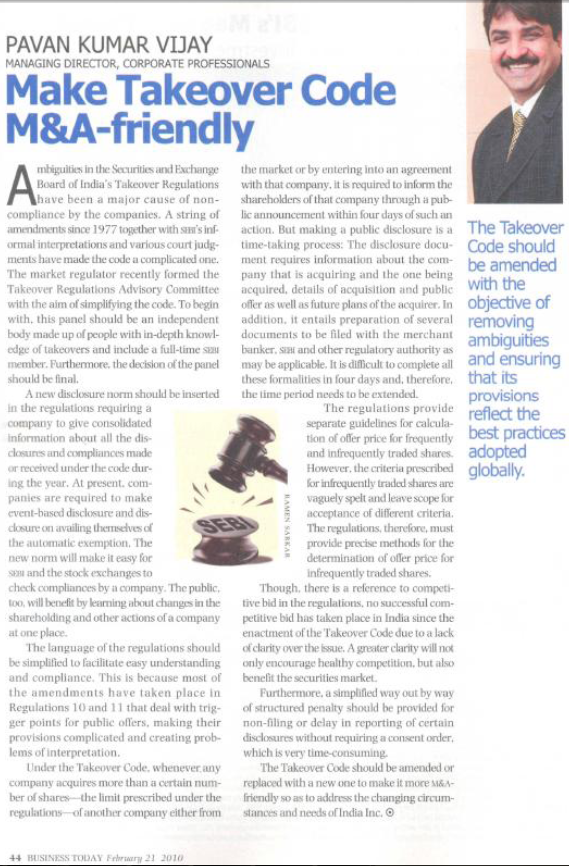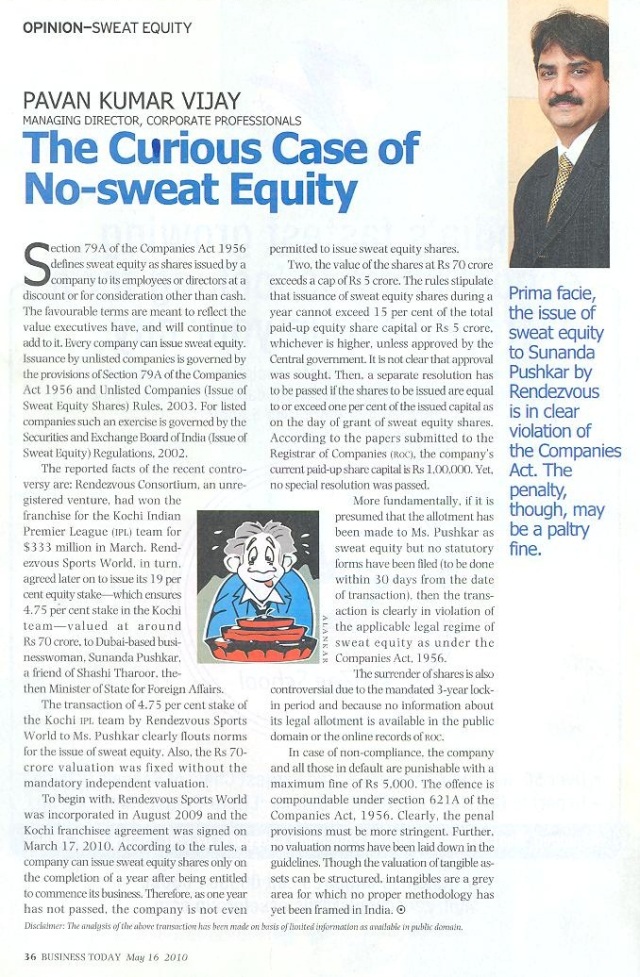
‘Start saving early’
BL RESEARCH BUREAU
29-May-2011
The habit of savings is best developed when young says Mr Pavan Kumar, Founder and Managing Director of Corporate Professionals, a merchant banking firm. In an interview with Business Line, he shares his experience and learnings from investing.
What are your top financial goals?
One, after I retire I should be able to earn sufficient income on my savings. Two, I should also have sufficient funds for my children’s education. I should also have ample amount of money for taking care of medical expenses and treatment, if any. And last, but not the least, is to plan my retirement depending on whatever liabilities I currently have or will have in future.
How has your idea about money changed with time?
Well, I am from a middle class family and used to live in a small town of Kasganj. Initially, I struggled a lot for my studies as well. I have thus realised the value of money very well. So, while initially money meant a means to fulfil basic needs of life, it later turned to luxurious needs. But the focus now is on saving money for building a better future.
Tell us about your most successful investment, one which made the most money for you?
My most valuable investment is in real estate. Whenever and wherever I have invested in real estate, it has given me a good return as compared to equity investments.
One mistake in investing or saving that you regret?
Most of us invest in equities and mutual funds but we always do one mistake – we marry our stocks when the market is going up. This is at a variance to the basic concept of equity, which requires us to sell them when the market is going up and buy when the market is going down. My biggest investment mistake was that I didn’t encash my equity investments when the market was at its peak.
How do you plan your investments – do you seek professional advice or do your own research?
I always plan my investments after doing proper research work and reading the market thoroughly.
I also listen to others but invest only after testing all the perimeters.
What has been your most important learning experience so far?
My most important learning is that one should start saving as early as possible. We shouldn’t worry about how much we can save, but should try to create the habit. Savings by way of investing in SIPs is good. Also, everyone should start investing in medical and other insurance policies when they are young. Doing this at a young age makes these instruments cost effective and helps in increasing your savings as well.
Tell us about books or investment guru that inspired you to think out of the box?
Warren Buffet has always inspired me, as he’s always had a different approach to investments.
What’s the amount of wealth you hope to retire with? How are you creating this corpus?
Honestly, there is no limit to one’s greed for money. But one should hope to create a corpus such that they aren’t dependent on anyone. As such there is no fixed amount of wealth that I am expecting at the time of my retirement. But I am investing in real estate, and equities, such that their value grows with the time.
How do you plan your investments to beat inflation?
Well, my investments are basically into the real estate, equities and fixed income, such that a combination of their returns will help me in beating the inflation.
What’s your message on savings and investing to young people just starting out on their career?
Create a habit for saving. Start with medical insurance at a young age itself. Also start SIPs early on, as it will always help you in beating inflation.
Download
Online Version of Published Interview
Print Version of Published Interview
![]()
Mon, 30 May 2011
Moves afoot to remove veil over corporate structuring
| The move would be the surest way to ensure transparency in operations from the promoter firm down to its remotest subsidiary. “It is a very smart move. Companies can’t argue with this since all that the government is asking for is transparency. It would restrict rampant intra-group activities,”
Pavan Kumar Vijay |
Concerned over the complex ways in which companies structure their operations and route funds from one subsidiary firm to the other, the ministry of corporate affairs (MCA) has come up with a unique solution to the vexed issue. It is considering directing companies to clearly chart out their various subsidiaries and layered subsidiaries in a ‘family tree’ format in their annual reports.
Also, companies would be required to spell out the movement of funds, if any, from one subsidiary to the other. This would give investors and government agencies a clear picture of the overall financial health of such group firms0
Layered subsidiaries refer to subsidiaries of subsidiaries, which makes it practically impossible for the government and its inspection agencies to detect the source of funds. As per the extant Companies Act there is no restriction on the number of such layered subsidiaries making it easier for companies to route funds from tax havens such as Mauritius and Cayman Islands. “Often investors are not in the loop as to how many layered subsidiaries companies have. As per current practice, companies often list out their various subsidiaries, but investors would not know how many of those are layered subsidiaries,” a government source said.
Legal experts and industry captains welcomed the government’s move. President of CII B Muthuraman told FE that the ministry’s step would create transparency in the operations of companies and benefit all stakeholders. Expressing a similar view, company law expert Pavan K Vijay who is also managing director of Corporate Professionals, said that the move would be the surest way to ensure transparency in operations from the promoter firm down to its remotest subsidiary. “It is a very smart move. Companies can’t argue with this since all that the government is asking for is transparency. It would restrict rampant intra-group activities,” he said.
The MCA is also hoping that once the eXtensible Business Reporting Language (XBRL) comes into effect keeping a tab on such layered subsidiaries would also become easier. XBRL is a company software language that reads and analyses company data in a systematic way.
Earlier this month , the MCA issued a circular mandating companies to start reporting their balance sheets and profit and loss account in this format by September 30 this year. “Once companies start reporting in XBRL format it would easily analayse the number of layered subsidiaries. It would be a good step,” the government source said.
The issue of layered subsidiaries first came to light when the Rs 8,000-crore Satyam scam erupted in January 2009. Its tainted chairman B Ramalinga Raju set up a multitude of layered subsidiaries to route funds from overseas destinations. The Enforcement Directorate (ED) and the Serious Fraud Investigations Office (SFIO) are still trying to locate the source of funds. Apart from that investigative agencies are currently investigating how some telecom firms had raised funds through their chain of subsidiaries overseas and routed them back to the country to buy spectrum. “The issue of a multiple chain of subsidiaries is very worrying. A system is required where investors would know exactly the number of such layered subsidiaries,” the government source added.
The parliamentary standing committee on finance headed by Yashwat Sinha had earlier proposed that the number of such layered subsidiaries should be capped. However, the MCA did not accept the recommendation fearing that it could impinge upon companies’ freedom to structure their operations for financial purposes. The ministry is trying to find a common ground between the PSC’s proposal and industry’s concerns.
MCA’s solution of a ‘family tree’ format for listing out layered subsidiaries comes at the backdrop of the North Block working on set of measures to curb the menace of black money. Last week the government set up a panel headed by chairman of Central Board of Direct Taxes Sudhir Chandra to examine ways to tighten regulations surrounding black money. The panel would submit its recommendations within six months. “Issues of black money laundering, beneficial ownership and money laundering are all inter-connected,” the source said.
Download
Online Version of Interview Published in : Financial Express
Print Version of Interview Published in : Financial Express





You must be logged in to post a comment.